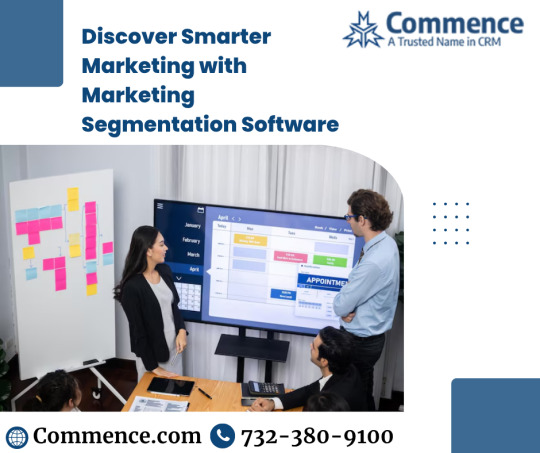#CustomerSegmentation
Explore tagged Tumblr posts
Text

Unlock targeted campaigns and boost engagement with Marketing Segmentation Software from Commence Corporation. This powerful tool helps businesses divide their customer base into meaningful segments, enabling smarter decision-making and highly personalized marketing strategies. Discover how precise segmentation can transform your outreach and drive measurable results.
0 notes
Text
What Is an Ideal Customer Profile and Why It’s Crucial for B2B Success

Struggling to convert leads?
It might not be your strategy—it might be your target.
An Ideal Customer Profile (ICP) is more than a marketing exercise—it's the foundation of high-performing B2B campaigns. When you clearly define who your ideal customer is, everything from lead qualification to messaging becomes sharper, faster, and more effective.
This blog breaks down:
What an ICP really means (and why it matters now more than ever)
How ICPs boost lead quality, reduce churn & improve customer lifetime value
A step-by-step guide to build your ICP using data, interviews, and real insight
Tips on aligning marketing, sales & leadership for accurate targeting
Whether you're refining your strategy or starting from scratch, building your ICP is the smartest move you can make to grow your B2B business.
Read the full blog post here: Click here
#IdealCustomerProfile#B2BMarketing#ICP#LeadGeneration#CustomerSegmentation#MarketingStrategy#SalesEnablement#DigitalMarketing#CustomerInsights#TargetAudience
0 notes
Text
Nuanced GenAI Deployment: A Fintech Debt Collection Case Study
youtube
Is AI the miracle solution for every financial services challenge? In this video, I explore why debt collection reveals the limits of the "just spray AI everywhere" approach that many fintechs are adopting. Using Klarna as a case study, I highlight how thoughtful GenAI deployment can transform customer service from a purely operational efficiency play into a relationship-building opportunity.
#FinTech#AIinFinance#CustomerExperience#DebtCollection#GenAI#CustomerSegmentation#ResponsibleAI#FintechInnovation#AIEthics#DigitalTransformation#SmartCollections#AIForGood#CreditLifecycle#HumanCentricAI#FinancialWellness#AIInCustomerService#Youtube
0 notes
Text

Building Your Personal Brand = Building Your Future
Imagine this: people refer you, trust you, and choose you—before even talking to you. That’s the power of personal branding. Whether you're an entrepreneur, coach, or creator, your personal brand speaks louder than your pitch. Every tweet, post, and story shapes how people perceive you. Are you shaping that narrative? Or letting it happen by accident?
🌟 Take control. Create purpose-driven content. 🧭 Let your brand lead your growth.
Follow @naveenbansal17 for step-by-step branding tactics.
#naveenbansal#Storytelling#Persona#PersonalBranding#Shopping#OnlineMarketing#CustomerSegmentation#DigitalPresence#googlebusinessprofiles
0 notes
Text
📌Project Title: Advanced Multi-Modal Customer Segmentation and Predictive Lifetime Value Engine.🔴
ai-ml-ds-custseg-ltv-003 Filename: multi_modal_customer_segmentation_and_ltv_prediction.py Timestamp: Mon Jun 02 2025 19:08:55 GMT+0000 (Coordinated Universal Time) Problem Domain:Marketing Analytics, Customer Relationship Management (CRM), E-commerce, Data Science for Business. Project Description:This project focuses on developing a sophisticated system for understanding and predicting…
#crm#CustomerSegmentation#DataScience#ecommerce#LifetimeValue#LTV#MachineLearning#MarketingAnalytics#pandas#python#ScikitLearn#SHAP#XGBoost
0 notes
Text
📌Project Title: Advanced Multi-Modal Customer Segmentation and Predictive Lifetime Value Engine.🔴
ai-ml-ds-custseg-ltv-003 Filename: multi_modal_customer_segmentation_and_ltv_prediction.py Timestamp: Mon Jun 02 2025 19:08:55 GMT+0000 (Coordinated Universal Time) Problem Domain:Marketing Analytics, Customer Relationship Management (CRM), E-commerce, Data Science for Business. Project Description:This project focuses on developing a sophisticated system for understanding and predicting…
#crm#CustomerSegmentation#DataScience#ecommerce#LifetimeValue#LTV#MachineLearning#MarketingAnalytics#pandas#python#ScikitLearn#SHAP#XGBoost
0 notes
Text
📌Project Title: Advanced Multi-Modal Customer Segmentation and Predictive Lifetime Value Engine.🔴
ai-ml-ds-custseg-ltv-003 Filename: multi_modal_customer_segmentation_and_ltv_prediction.py Timestamp: Mon Jun 02 2025 19:08:55 GMT+0000 (Coordinated Universal Time) Problem Domain:Marketing Analytics, Customer Relationship Management (CRM), E-commerce, Data Science for Business. Project Description:This project focuses on developing a sophisticated system for understanding and predicting…
#crm#CustomerSegmentation#DataScience#ecommerce#LifetimeValue#LTV#MachineLearning#MarketingAnalytics#pandas#python#ScikitLearn#SHAP#XGBoost
0 notes
Text
📌Project Title: Advanced Multi-Modal Customer Segmentation and Predictive Lifetime Value Engine.🔴
ai-ml-ds-custseg-ltv-003 Filename: multi_modal_customer_segmentation_and_ltv_prediction.py Timestamp: Mon Jun 02 2025 19:08:55 GMT+0000 (Coordinated Universal Time) Problem Domain:Marketing Analytics, Customer Relationship Management (CRM), E-commerce, Data Science for Business. Project Description:This project focuses on developing a sophisticated system for understanding and predicting…
#crm#CustomerSegmentation#DataScience#ecommerce#LifetimeValue#LTV#MachineLearning#MarketingAnalytics#pandas#python#ScikitLearn#SHAP#XGBoost
0 notes
Text
📌Project Title: Advanced Multi-Modal Customer Segmentation and Predictive Lifetime Value Engine.🔴
ai-ml-ds-custseg-ltv-003 Filename: multi_modal_customer_segmentation_and_ltv_prediction.py Timestamp: Mon Jun 02 2025 19:08:55 GMT+0000 (Coordinated Universal Time) Problem Domain:Marketing Analytics, Customer Relationship Management (CRM), E-commerce, Data Science for Business. Project Description:This project focuses on developing a sophisticated system for understanding and predicting…
#crm#CustomerSegmentation#DataScience#ecommerce#LifetimeValue#LTV#MachineLearning#MarketingAnalytics#pandas#python#ScikitLearn#SHAP#XGBoost
0 notes
Text
Business Profiling and Customer Segmentation: A Perfect Match
Understanding the target audience is crucial for any successful marketing strategy, and business profiling plays a vital role in achieving that. By implementing structured customer profiling methods, companies can gain deep insights into their customer base—segregating them based on demographics, behavior, preferences, and purchasing power. This process helps businesses create customized marketing campaigns that resonate with different segments.
Commence Corporation emphasizes the value of blending business profiling with customer segmentation to enhance overall performance. When done right, profiling goes beyond basic customer data. It identifies high-value clients, predicts future buying behavior, and helps align products or services with customer expectations. Whether it's a startup looking to build a solid foundation or an established enterprise aiming to refine its strategy, having detailed customer profiles helps reduce guesswork and improve ROI.
Moreover, business profiling also supports sales teams by equipping them with actionable data. Instead of relying on generic pitches, sales reps can approach prospects with tailored messaging, making their efforts more effective. In the long run, profiling strengthens customer relationships and builds brand loyalty.
Commence Corporation offers tools that simplify the profiling process—collecting, organizing, and analyzing customer data through intelligent software features. These solutions are designed to help businesses unlock growth opportunities and optimize customer engagement.
In an increasingly competitive digital landscape, leveraging business profiling isn't optional—it's essential.
#BusinessProfiling#CustomerSegmentation#CommenceCorporation#MarketingStrategy#CustomerInsights#SalesOptimization
0 notes
Text
Personalized Marketing Using HubSpot
In retail, it’s not just about reaching more prospects — It’s about reaching the right ones.

One retail client we worked with boosted sales by 27% in just 3 months by using HubSpot’s CRM segmentation and targeting. Here’s what made the difference:
✅ Identified high-value customer segments and sent targeted promotions ✅ Triggered automated email journeys based on real-time behavior ✅ Used data to predict buying intent and time offers perfectly
📉 Blanket campaigns no longer drive results. 📈 Smart segmentation turns browsers into buyers—and buyers into loyalists.
🔗 Want to see what segmented marketing could do for your growth? Let’s talk:
#TransFunnel#HubSpot#Marketing#CustomerSegmentation#RetailMarketing#HubSpotCRM#PersonalizedMarketing#DataDrivenGrowth#AutomateSuccess
0 notes
Text
How Customer Segmentation Can Revolutionize Your Marketing Campaigns

Discover how customer segmentation can revolutionize your marketing campaigns by targeting specific audience groups effectively. Leveraging AI Swades, you can harness the power of data-driven insights to personalize strategies, increase engagement, and boost ROI. Transform your approach by understanding your audience better and delivering tailored experiences that resonate. Start making smarter marketing decisions today.
0 notes
Text
Nuanced GenAI Deployment: A Fintech Debt Collection Case Study
youtube
Is AI the miracle solution for every financial services challenge? In this video, I explore why debt collection reveals the limits of the "just spray AI everywhere" approach that many fintechs are adopting. Using Klarna as a case study, I highlight how thoughtful GenAI deployment can transform customer service from a purely operational efficiency play into a relationship-building opportunity.
#FinTech#AIinFinance#CustomerExperience#DebtCollection#GenAI#CustomerSegmentation#ResponsibleAI#FintechInnovation#AIEthics#DigitalTransformation#SmartCollections#AIForGood#CreditLifecycle#HumanCentricAI#FinancialWellness#AIInCustomerService#Youtube
1 note
·
View note
Text

Consistency: The Backbone of Brand Success
What’s the difference between a one-hit wonder and a lasting brand? Consistency. While viral posts might bring spikes in reach, they rarely build long-term loyalty. True marketing success comes from creating valuable content on a regular basis. Make your audience feel seen, heard, and supported. Create with the goal of impact, not instant fame. If you solve real problems consistently, people will trust you. And with trust comes growth, engagement, and conversions.
https://naveenbansal.com/
#naveenbansal#MarketingCoach#OnlineBranding#SocialMediaGrowth#HighIntentMarketing#BrandVoice#CustomerSegmentation#OnlineBusinessCoach#ContentWins
0 notes
Text
Customer Lifetime Value Forecasting and Behavioral Segmentation using Pandas, K-Means, and Survival Regression Models.
Customer Lifetime Value Forecasting and Behavioral Segmentation using Pandas, K-Means, and Survival Regression Models Unique Reference: ai-ml-ds-F98ZkLvxRqmFilename: customer_lifetime_value_forecasting.py This project forecasts the Customer Lifetime Value (CLV) and segments customer behaviors using: Pandas for data wrangling, K-Means for clustering, Lifetimes & scikit-survival for CLV and…
0 notes
Text
Customer Lifetime Value Forecasting and Behavioral Segmentation using Pandas, K-Means, and Survival Regression Models.
Customer Lifetime Value Forecasting and Behavioral Segmentation using Pandas, K-Means, and Survival Regression Models Unique Reference: ai-ml-ds-F98ZkLvxRqmFilename: customer_lifetime_value_forecasting.py This project forecasts the Customer Lifetime Value (CLV) and segments customer behaviors using: Pandas for data wrangling, K-Means for clustering, Lifetimes & scikit-survival for CLV and…
0 notes